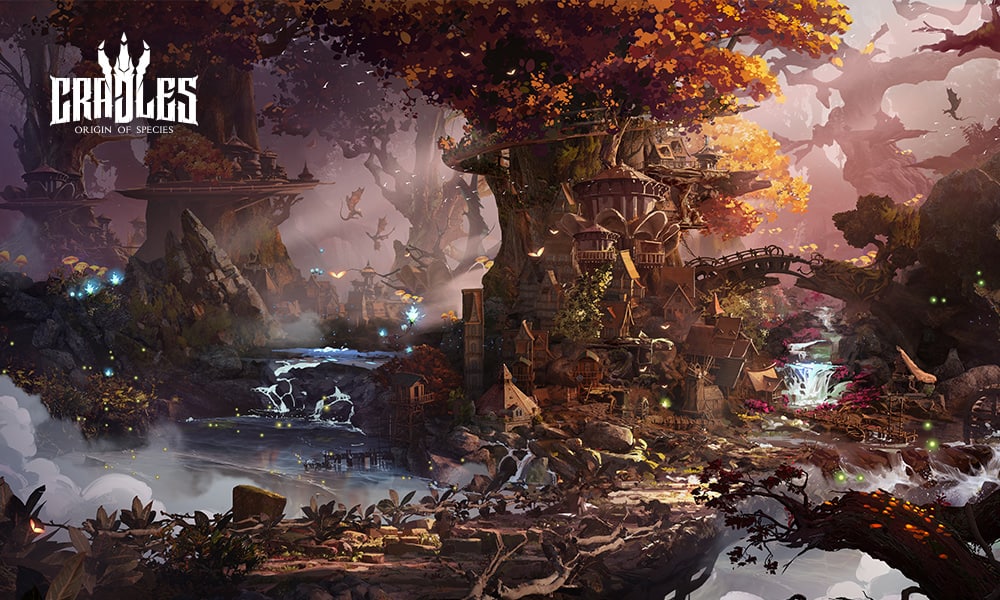The popularity of non-fungible tokens, or NFTs, has never been greater, due to the increased interest in them over the past few years, especially within the art and collectibles scene. In the same time, it has enjoyed tremendous success within the blockchain gaming market.
Although the technology has existed since 2016, NFT art, and more specifically, NFT games, are solid proof that the utility of crypto assets goes beyond the purchase and sale of digital assets and into something more concrete and tangible.
In fairness, the market for NFTs that has expanded to one of billions of dollars continues to be predominantly in the digital art sector – collectible GIFs and JPEGs that prove ownership of unique pieces of art celebrating the internet and crypto meme culture.
There is already an evolution in the definition of NFT and blockchain MMORPG Cradles has made this possible with their innovative innovation.
This isn’t to say that static images (or really, coordinates that point to an immortalized stamp of the original image) haven’t had their role in how successful NFTs have been. Without the awe-inspiring success of Bored Apes Yacht Club, or CryptoPunks’ groundbreaking breakthrough for crypto pop, NFTs may have been confined to technospeak and geekery.
Despite being widely accepted, the ERC-721 protocol was not intended to be more than a unique representation of physical objects in digital space.
NFTs, in current form, are therefore subject to their own limitations. They can only store a small amount of data on tokens, which is the limit of their protocol.
Though NFT gaming has also taken decentralized applications and Web3 over some remarkable milestones – gaming Dapps are still the most popularly used applications in the decentralized space – the most successful aspect of an NFT (non-fungibility) is holding it back from reaching higher achievements.
For an NFT to be solely reliant on its perceived rarity aspect (again, a highly subjective matter) simply isn’t enough to sustain interest and further technology – and in gaming, where inventiveness and creativity are the only markers of progress, NFTs on their current limits are at the end of the innovation road. Evidence of this is the shrinking speculative market for NFTs.
This is where the EIP-3664 proposal – developed by DRepublic, the makers of blockchain MMORPG Cradles – enters the picture to provide a new standard for NFTs and how they are defined.
What’s the EIP-3664 Process?
EIP-3664 is just like every EIP before. It includes advancements in tokens on Ethereum’s blockchain, and essentially all of the other major blockchains that are compatible with Ethereum.
EIP-36664 is a way for players to interact with NFTs, rather than simply using static NFTs that are not able to be modified in games.
Players would be able to create “component” NFTs, crafting them from basic raw materials (themselves malleable NFTs), and changing the traits of an NFT within a game simply by adding and removing other components. The NFTs can be made dynamic so that they are able to adapt and evolve with the game’s gameplay. They also have the ability to sell or transfer their original abilities.

EIP-3664: Changing the game
DRepublic’s work on the EIP-3664 proposal is intended to be the technological core of its upcoming game, Cradles: Origin of Species. Gamers would be able finally to interact and create every element in their virtual world. They could even disassemble and assemble items and materials. All of these components would become tokens which can be combined and customized in infinite ways.
NFTs will allow for the representation of all these items, buildings, clothes, equipment and characters using fungible or non-fungible abilities. This allows them all to evolve and change.
These NFTs, instead of having a central server that determines the phases of time in each phase of each game’s history, will try to create a metaverse. Cradles’ unique “entropy-increasing” world will see players, their items, and their environment constantly evolving as (block) time passes.
Cradles founder T.Y. explains how EIP-3664 creates this possibility by allowing “NFTs to carry significantly more information, resulting in various new types of NFTs that can be assembled and combined freely, giving them variable properties that would enable almost any functions one might desire in an NFT.”
A New Era Of NFTs
One important thing about NFTs that are created using EIP-3664 tokens, is their ability to be collected. They expand the potential for these NFTs in gaming. These NFTs are basically taken from speculative use and placed in an environment that can offer real utility. They become easily configurable in-game items or building blocks to a continually evolving metaverse.
EIP-36664 NFTs are used by players in video games to create NFTs. You can remove and modify attributes of other materials or items into NFTs. Also, you can disassemble an NFT to distribute its attributes to NFTs or to sell the attributes. This adds an additional layer of value to the NFTs, while maintaining the same collectible idea that has made them so popular.
Enter Dragontar NFTs
Dragontar NFTs were the first to implement the EIP-366 tokens. They are not part of the Ethereum blockchain. It was launched via a portal called the Dragontar Club, which is now referred to as the world’s first combinable NFTs.
Dragontar NFTs represent the community’s growth and members desire to have their own NFTs. NFTs can be modified as players wish.
“Unlike other NFTs that can only be traded once bought, players can perform operations on EIP-3664 NFTs,” said Y.T. “Since they’ll need a workplace for this, we published our all-in-one platform: Metacore, a brand new marketplace, and workplace for 3664 NFTs. Anyone with a Dragontar can visit, click on the workplace, and perform operations on their NFTs.”
The fast approaching Ethereum Merge will highlight new innovations like EIP-3664 for their distinctive offerings. One example of this is the modular NFTs used by DRepublic for the Cradles: Origin of Species video game. This already looks set to be the beginning of the next generation of Blockchain gaming.